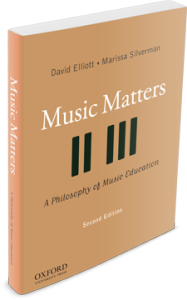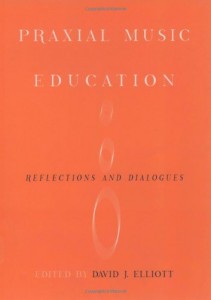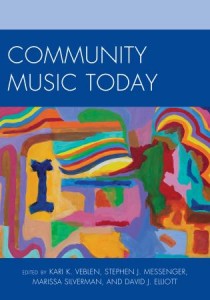In the Preface of MM I thanked many people from different fields who assisted me in developing the praxial philosophy. In addition, I emphasized the personal aspect of philosophy building: “no philosophy can be completely objective because a philosophy of something (no less than a scientific theory of something) can never be without personal and professional interests” (MM, p. 19). In other words, the development of the praxial philosophy was not a purely theoretical process. For one thing, it was shaped by many discussions with colleagues and students over many years; for another thing, my own musical-educational history had a powerful influence on what I wrote in MM (as Veblen documents in chapter 17). Included in this personal history were my background experiences as a child-listener, a junior high school and high school student performer-arranger-conductor, a professional performer and jazz improviser, a published composer and arranger of instrumental and choral works, a secondary school music teacher (teaching band, general music, and composition), and my observations of many kinds of music educators working in different parts of the world. Also, my earliest musical experiences were always present in my mind and feelings as I developed the praxial philosophy.
Also, as I just highlighted in my introduction (via Regelski’s words), many sources from the fields of curriculum and instruction hold a prominent place in MM. After all, MM is a philosophy of music education, not just a philosophy of music. Accordingly, most chapters of MM link issues of musicing, listening, musical works, creativity (and so forth) to educational strategies that are constructivist in nature, including these: targeting attention, coaching, modeling, problem finding, problem solving, scaffolding, articulation, and fading. These strategies are very familiar to me, theoretically and practically, because I employed them in my work as a secondary school band and jazz band teacher, a composition teacher, a teacher of music listening, an African drumming teacher, and a music-teacher educator.
In summary, I built the praxial philosophy from the ground-up and from the top-down. Praxialism rests on a combination of (a) my practical and educational experiences as a musician and teacher, (b) my studies of philosophical, educational, psychological, and other scholarly sources, and (c) and my intuitions about all these components.
With these thoughts in mind, let me move to my first “dialogue.” In chapter 3 of PME Bowman provides a luminous synthesis-and-analysis of most tenets and nuances of praxialism as formulated by Alperson and Sparshott. Following this, he analyzes my application of these praxial themes. While I agree with many of his points, I see a need to clarify some issues. For example, at one point Bowman says that (on purely theoretical grounds) praxial convictions cannot yield “a comprehensive view of all music or music education” (p. 161). Well, yes, but praxialism isn’t alone in this regard because it’s very doubtful that any human being could create “a comprehensive view of all music or music education.” Second, as you can see from the preceding paragraphs, it was never my intention to build a philosophy of music education on praxial-musical views alone. For one thing, praxial views of music only imply educational guidelines and strategies. For another thing, neither Alperson nor Sparshott tell us everything we need to know about musical works, musical values, the workings of music listening, and so forth. Thus, a philosophy of music education must be developed with additional help from other scholars and sources (e.g., scholars of music cognition, consciousness studies, psychology).
A related criticism is that “while the idea of praxis is central to Elliott’s project, there really is relatively little direct mention of the term or idea for a book that has come to be so singularly identified with praxial philosophy. Elliott’s view of praxis is drawn on the basis of a few references to Aristotle” (Regelski, p. 227). I don’t agree. As Bowman shows (pp. 64-72), I apply many themes from the praxial writings of Alperson and Sparshott, not just a few references to Aristotle. In any event, and in answer to my colleagues, I viewed my philosophy-building project as one that required me to go beyond the ideas laid out by Alperson and Sparshott. In other words, I chose to call MM a “praxial” philosophy because the core meaning of “praxial” came closest to encapsulating the key ideas I put forth, not because I was intent on restricting MM to the ideas of Aristotle, Alperson, and/ Sparshott.
Chapter 3 of PME adds a variation on the idea that praxial philosophical convictions are “insufficient” to a philosophy of music education (Bowman, p. 75), meaning that “music education is not just about music, it is about students, and it is about teachers, and it is about the kind of societies we hope to build together” (p. 75). Yes, I agree: a philosophy of music education should center on students and teachers. So, is Bowman criticizing praxialism in general (which, in fact, takes all kinds of people into consideration, as Bowman makes clear), or is he criticizing MM? If it’s the latter, I believe there is considerable evidence in MM that my version of praxialism is seriously concerned with students and teachers, and many others, as later sections on this web site reinforce (see: Values and Affect; Multicultural Music Education; and Music and Identity).
Next, I wonder about the remark that my interpretation of Aristotle’s “right action” is incomplete because it only includes “active engagement in active music making” (Regelski, p. 227). First, I think it’s fair to say that MM includes the natures, values, and teaching of “right action,” which I take to mean the social-personal-cultural actions and contexts of musicing and listening. Perhaps Regelski’s criticism is based on one specific part of my discussion of “musicing in context” (MM, p. 175)? Indeed, even at the outset of MM I state that “praxis” means something much larger and more complex than “right action” alone: “praxis connotes action that is embedded in, responsive to, and reflective of a specific context of effort” (p. 14). Regelski acknowledges this larger scope later in his essay (p. 228) where he discusses the existential and humanistic dimensions of my view of praxialism.
Another foundational issue concerns two related claims: (a) that the “the core” of my argument is that all music everywhere consists essentially in “procedural knowledge” as exemplified in performing and, therefore, (b) that I believe that “the only valid way to grasp music’s procedural essence (that is, to develop musicianship) is to perform it, and the corollary that instruction which neglects performance fails to educate musically” (Bowman, p. 65). I see two basic problems these claims. As I make clear at the outset (MM, pp. 39-45), my “core” beliefs are several, beginning with the central idea that Musics are multidimensional, social-cultural practices. Yes, a key part of my discussion of musical practices is the concept of “procedural knowledge,” which is one of five kinds of thinking that enable musicing to take place in every musical practice (MM, p. 54). But Bowman does not discuss the equally basic concept of “procedural knowledge” as it applies to listenership (MM, pp. 84-87), let alone my many references to the interlocking of musicianship and listenership in action, and the simultaneous teaching of music and listening (for example: MM, pp. 94-96). Indeed, throughout MM I insist that musicianship always includes listenership: “The connection between listening and musicing is therefore intimate, to say the least. Music listening and music making are mutually interdependent; they are two sides of the same coin” (MM, p. 103) Here is another relevant quote from MM:
Music listening ought to be taught and learned in classroom situations that music teachers deliberately design to approximate authentic musical practices . . . the name for this kind of teaching-learning situation is curriculum-as-practicum. A music curriculum based on authentic music making serves to contextualize and situate listenership and its component knowings. (MM, pp. 101-102)
Please not that I refer to all forms of music making in the above passage (more on this topic under Musicing-and-Listening). In short, as Westerlund and Juntunen affirm: “Elliott’s concept of thinking-in-action (as a music maker and a music listener) is central to his integrated concepts of musicianship and listenership” (PME, p. 119). Thus, and in contrast to Bowman’s interpretation of a sentence from MM (following next), my point in calling music a “performing art” was to highlight the many “ingredients” involved in “music” considered as a social-sonic phenomenon. Allow me to underline key words in the sentence from MM that Bowman cites (PME, p. 65) in order to draw attention to these ingredients: “Each and every aspect of a musical work that we listen for is always the result of an individual or collective interpretation and performance of a composer’s musical design, or an improvised design, or a performers rendition of a remembered design [italics added]” (MM, p. 95). So, to me, performing is one link in a chain of events and dimensions. Still, I admit that I should have been clearer on this important issue.
In summary, I do not believe or say that performing should be the only form of instruction we should use in music education. As Pam Burnard confirms:
“the praxial view of general music education affirms the complexity of children as reflective music makers and validates listening, performing, improvising, composing, arranging, and conducting as interdependent forms of creative doing” (PME, p. 267).
Another criticism Bowman makes (p. 67) is that my argument for multicultural music education doesn’t necessarily follow from my praxial foundations. I’ll address his concern under that heading.
Lastly, I would like to respond in a preliminary way to the issue of teaching music by means of recordings alone, or “just listening” (as in “music appreciation”). I have much more to say on this topic under Musicing-and-Listening. For now, let me point out that since all forms of musicing (performing, improvising, composing, arranging, and conducting) occur in the social-cultural contexts of specific musical practices, I hold that there is no such thing as “just performing” (or “just composing,” and so forth); likewise, there is no such thing as “just listening” (see Regelski, chapter 12). Put another way, while singing is not a praxis, urban blues singing is, and Baroque choral singing is, and so forth. Similarly, while composing is not a praxis, bebop jazz composing is, and Baroque choral composing is, and so forth. And so it follows that while “just listening” is not a praxis, urban blues listening is, and Dixieland jazz listening is, and bebop listening is, and Baroque choral listening is. In other words, listeners require contextual listening know-how to make sense of each style of music. Everything about “music” is social-contextual, as Bowman explains so well (PME, chapter 3). It is important to observe, therefore, that even when students are “just listening” to music outside school for their enjoyment, they are still listening to particular kinds of music by virtue of specific kinds of listenership. Is it possible to become a “highly refined” listener without the benefit of some kind of music-making experience (Bowman, p. 153)? I address this question under Musicing-and-Listening.
Second, as I also explain in Musicing-and-Listening, I fully endorse the use of recordings in music education when recordings are used in the context of a comprehensive curriculum that includes music making – all forms of musicing, not just performing. Nowhere in MM do I say that we must choose between teaching performing (and/or other kinds of musicing) and teaching listening. In chapter 8 of PME, Bowman seems to imply otherwise. No, I want musicing and listening taught in mutually supporting ways. So, it’s incorrect to say that I fervently renounce listening as instructional method (Bowman, PME, p. 144). Woodward (for example) affirms that basic aspects of the Orff, Kodaly, Dalcroze, and Suzuki approaches “dovetail with Elliott’s belief that children’s musicianship is developed through the combination of listening and making music and accompanying processes: reflecting on the sounds created and how actions alter those sounds; determining goals for sound production; solving and seeking musical problems” (253). Indeed, I argue for teaching performing (for example) as a critical, reflective process of interpreting, not just sound producing (MM, p. 271).
I will say more about teaching music via recordings under Musicing-and-Listening, Values and Affect, and Multicultural Music Education. Suffice it to say that my objections to “just listening” courses based on recordings alone are mainly aimed at the shortcomings of general music programs based on the ideals of “aesthetic education,” not the use of recordings per se. To foreshadow what I explain further on, let me highlight two passages from Bowman’s excellent discussion of the pros and cons of music instruction based on listening alone (PME, chapter 8). At one point in his essay, Bowman quotes the words of ethnomusicologist Charlie Keil:
“In order to understand what any musician is doing, you have to have done some of it yourself. I used to think you could do it just through listening, but that alone won’t let you connect to the music or to other people. Unless you physically do it, it’s not really apprehensible, and you’re not hearing all there is to hear in the music” (PME, p. 149).
At another point, Bowman speaks to the inadequacy of music instruction centered on listening to recordings alone.
“listening, even at its most active, is receptive, submissive, attentive – an act in which self is suppressed, and in which the heard is paramount. If musical performance is a kind of self expression, or self assertion, musical listening (particularly if it is without benefit of performing experience) might be characterized as an act of self-suppression” (PME, p. 156).



